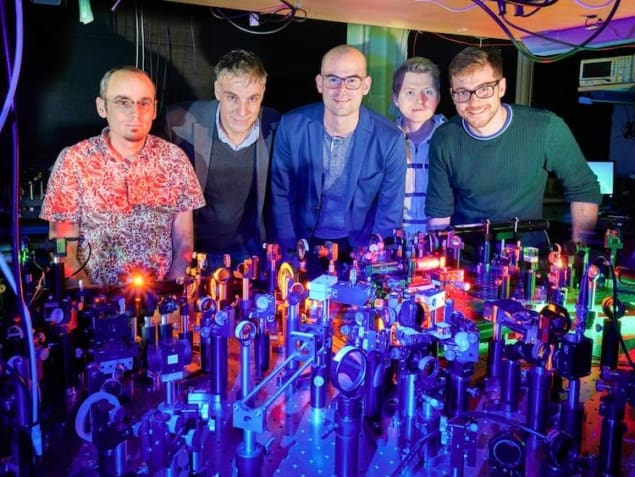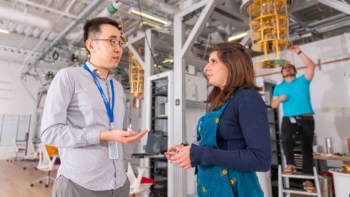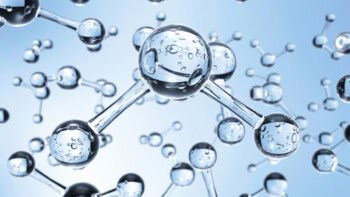
Researchers at the universities of Bonn and Cologne in Germany have developed a new way of splitting photon wavepackets that involves cooling them down to a Bose–Einstein condensate (BEC) in a double-ridge microresonator structure. This thermodynamic method differs from the usual optical beam-splitting techniques because it is irreversible, meaning that the original beam cannot be reconstructed. The BEC-based process might be extended in the future to make new optical sources for entangled and correlated light states for applications in quantum computing.
The research team was led by Martin Weitz from the Institute of Applied Physics at Bonn University, who made headlines in 2010 when he and his colleagues created the first BEC from photons – 15 years after the first BEC was made in 1995 from a cloud of rubidium atoms cooled to a fraction of a degree above absolute zero. BECs form when bosons (particles with integer quantum spin) are cooled until they are all in the same quantum state. At this point, a BEC made up of tens of thousands of particles will behave as if it were in fact just a single quantum particle.
First photon BEC
Weitz and his colleagues made their photon BEC, or “super-photon”, by firing a laser beam into a microresonator cavity made of two concave mirrors separated by about a micron. This separation defines (to within an integer multiple) the maximum wavelength, and thus the minimum energy, of a photon trapped longitudinally within the cavity. The cavity is filled with a dye solution that is held at room temperature, meaning that its thermal energy is only about 1% of the energy of the photons.
Because the dye has so much less energy than the photons, it is highly unlikely that additional photons will emerge from the dye, or that the dye will completely absorb a photon. What happens instead, Weitz explains, is that when the photons collide with the dye molecules, they are briefly “swallowed” and then spat out again. After repeated absorption and re-emission cycles, the photons acquire the temperature of the dye solution and are thus cooled down to room temperature without being lost.
By increasing the laser intensity irradiating the dye solution, the researchers increase the number of photons in the cavity until it reaches about 60,000. This strong concentration of the light particles, combined with simultaneous cooling, causes the individual photons to coalesce into a photon BEC – much like a liquid drop condensing in a gas.
Photons pass into lower-energy states
In their new work, Weitz’s team used the same experimental set-up as before. This time, however, one of the two cavity mirrors was not completely flat. Instead, it contained two small valley-like optical ridges, or potential energy minima. When the laser light beam enters one of these ridges, the distance it travels, and therefore its wavelength, increases slightly. As in previous work, the photons in this beam are cooled by the dye solution before passing into a lower-energy state in the ridges.
The study’s lead author, Christian Kurtscheid, compares the photons in their system to marbles rolling over a sheet of corrugated metal. Whereas marbles with a high velocity would simply skip over the sheet’s surface, slower marbles will settle in the valleys of the corrugations. Similarly, the cooled photons in their experiment “roll into the valleys of the ‘corrugated sheet’ and remain there,” Kurtscheid says.
Tunnel coupling
In the experiment, the two ridges are close enough together to allow for a phenomenon called tunnel coupling, he says. This means it is no longer possible to determine which photons are in which ridge – only that they are in the lowest energy state in the cavity. “This state is the symmetric linear combination of photons localized in the two potential minima,” Weitz explains. “We observe that the photons condense into a BEC into this low-energy, spatially bifurcated state.”
This process irreversibly splits the wavepackets of light as if they were passing through an intersection at the end of a one-way street while the tunnelling between the ridges leads to one of the hybridized wavefunctions of the photons coupling.

Exciton condensation breaks new temperature record
Irreversible, coherent light splitting
The researchers observed the light wavepacket splitting by using a camera to monitor the optical radiation transmitted through one of the cavity mirrors. They also monitored the coherence of the beamsplitting by recombining the light beam paths. In this way, they were able to observe interference fringes of the beams.
“Our technique is a new, energetically-driven way to prepare optical quantum states,” Weitz tells Physics World. “We have demonstrated how to irreversibly create coherently split light.”
The method, which is detailed in Science, might be extended in the future to realize new optical sources for entangled and correlated states of light, he adds.
The researchers now plan to prepare photons in a periodic lattice potential and enhance effective photon interactions. In such a set-up, highly entangled many-body states can become the lowest energy state in the cavity. “We could directly populate these quantum states by cooling using our method and these states could be used in applications such as quantum information and communication,” Weitz says.



